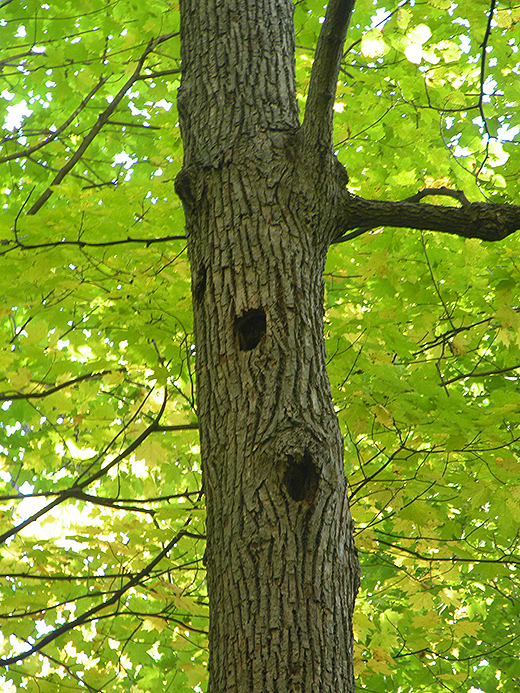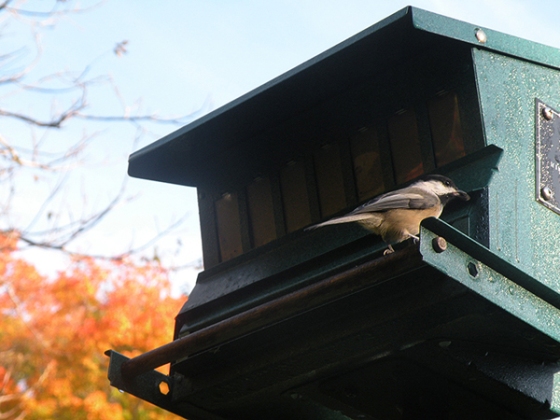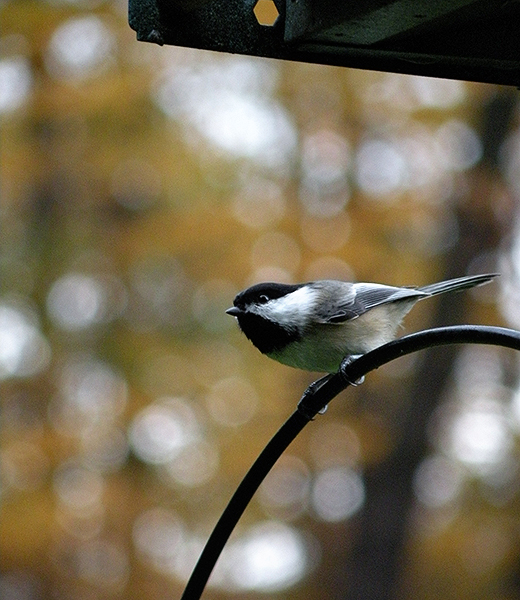Black-capped Chickadees, Poecile atricapillus, are year round songbirds native to North America.3 Their habitat ranges from the Maritimes up to Alaska, covering 2/3 of Northern and Central United States.3,4. Living in flocks of four to twelve birds, Chickadees can be seen in different habitats such as orchards, deciduous and coniferous woodlands, cotton wood groves, parks and other wooded areas.2,3,4 They may also be found near the edges of forests.2 These habitats provide nesting sites as well as food.2 By the end of March, “1-2 weeks before egg laying”2, female Chickadees build their nests in abandoned cavities excavated by woodpeckers or other natural cavities.1 Females might also, with the help of males, excavate their own cavities in the rotting wood of stumps1,3 Here, female Chickadees lay seven eggs per season on average.4

Tree cavities near Research Site #1, a prime location for black-capped chickadees to roost and sleep
During the breeding season, Chickadees forage mainly for caterpillars, as well as fruits and seeds.2 During the winter, their diet primarily consists of insects, spiders, berries and seeds.2 Chickadees may be observed feeding at birdfeeders, or even on animal carcasses.1,4 Although these birds are notoriously bold and audacious for their size, they are vulnerable to predators such as owls, small hawks and shrikes.4 Chickadees make sharp “zeet” calls to alert others to the presence of predators.4 On average, they have fifteen different calls for different purposes, including the well-known “chickadee-dee-dee” call which inspired the bird’s name.3
(Video: Vocalizations of Black-Capped Chickadees at Research Site #2)
Black-capped Chickadees change their feeding and territorial behaviours over time in order to survive cold winter conditions.8 They are known to alter their vocalization, flocking behaviour, breeding territories, food sources and caching storages over the year.7 Chickadees have physiological and ecological adaptations for winter survival such as nocturnal hypothermia, the reduction of their body temperature over night; thermogenesis, shivering to produce heat; over-wintering in heterospecific bird flocks, commonly with woodpeckers and nuthatches; foraging at lower heights for increased wind protection, and caching, storing food in autumn for later consumption during the winter.8
During the fall, Black-capped Chickadees can be observed eating at bird feeders -especially those with black sunflower seeds- and also frequently caching seeds, usually those of coniferous trees. Chickadees can fly upside-down and belly-up in order to extract seeds from branches and cones using their claws and beaks. According to Barbra Frei5 of the McGill Bird Observatory (MBO), Chickadees must eat about 10-15 percent of their body weight during the day to preserve enough energy to last the night. Chickadees fluff up their feathers while shivering in order to stay warm. They also travel in pairs or in small flocks to the feeders and from tree to tree.

A Chickadee preparing to take flight with a black conifer seed in its beak demonstrating caching behavior
(Video: Caching and Feeding Behavior of Black-Capped Chickadees at Research Site #1)
The specific focus of this project is on the behavior of Black-capped Chickadees, and how it changes with the approach of winter. To measure this, we constructed a data sheet with observable behaviors including feeding, foraging and caching as well as physiological adaptations such as shivering. Our aim is to observe the change in behavior and frequency of Chickadee activity at each research site over time. Our own eyes and ears have proven to be our most valuable tools, but technology such as a GPS device has enabled us to pinpoint the exact location of each research site and measure their approximate areas.
The three sites are all near the Orange Trail, a 3 kilometer loop in the Morgan Arboretum. Site one is a fairly open area of planted trees (including some exotic species) with a bird feeder and a high frequency of Black-capped Chickadee activity. Site two is between two rows of trees, allowing us to observe activity in a forest edge environment. Site three is in a mostly-coniferous and denser part of the Arboretum, with a high canopy. All sites include conifer trees, a major food source. Our procedure has been to split up into two groups of two, which start the loop in opposite directions in order to gather two sets of data (20 minutes per site) for each study site on each day.
We have collected data over the month of October, going to the Arboretum twice a week in the morning, once from 8am to 10am and once from 10am to 12pm. This allows us to observe differences in Chickadee behavior over the course of the morning, as temperature rises. The Black-capped Chickadee’s food caching begins in September and ends in February.7 Research site one has shown constant caching behavior from Chickadees as couples regularly come to the feeder to pick up seeds, then fly away within half a km to visibly peck at bark or lichen to store them. Other Chickadees who are visibly feeding by picking up a seed, breaking and instantly consuming it are fattening up either to facilitate nocturnal hypothermia or prepare for partial migration.
As the temperature and hours of sunlight decrease over the fall season, the Black-capped Chickadee must undergo observable physiological behavior such as shivering (thermogenesis) in order to survive, as there is only 2cm between the harsh winter conditions and their body cores.8 Thermogenesis can be identified by a change in posture and erection of the feathers as an initial response to colder temperature.8 As the season progresses, the Chickadees’ shivering bursts increase in frequency, mean duration, and magnitude.8
The social and hierarchical behaviour of Black-capped Chickadees does not observably change during the fall. The only Chickadees who are not associated with a flock or paired up with a mate are those which have hatched this year. These juveniles are smaller and are observed to undergo more feeding behavior than caching, indicating they are having the hardest time adapting to winter conditions. Black-capped Chickadees must increase their efficiency of energy use and storage to survive harsh winter nights8, and we have observed multiple flocks of Chickadees roosting in tree cavities close to plentiful food supplies of conifer seeds near research sites one and two, significantly lowering travel time and distance from their foraging areas.
(Video: Phishing Behavioural Response of Black-Capped Chickadees)
References
- The Cornell Lab of Ornithology. (n.d.). All about birds: Black-capped chickadee. Retrieved from http://www.allaboutbirds.org/guide/black-capped_chickadee/lifehistory
- Smith, S. M. (2010). The birds of north America: Black-capped chickadee. Retrieved from http://bna.birds.cornell.edu/bna/species/039/articles/behavior
- Lawrence, L. K. (2003). Hinterland who’s who: Black-capped chickadee. Retrieved from http://www.hww.ca/en/species/birds/chickadee.html
- Roof, J. (2002). Parus atricapillus: Black-capped chickadee. Retrieved from http://animaldiversity.ummz.umich.edu/accounts/Parus_atricapillus/
- Barbra Frei, Masters in Ornithology at McGill University and member of the staff at the McGill Bird Observatory bird banding station in Sainte-Anne de Bellevue.
- Munib and Yifu from the ENVB-222 course with Chris Buddle studying Chickadees in fall 2012.
- Otter, K. A. 2007. The Ecology and behaviour of Chickadees and Titmice; An integrated approach. Oxford Ornithology. Oxford University Press. United States. pp. 43-52
- Otter, K. A. 2007. The Ecology and behaviour of Chickadees and Titmice; An integrated approach. Oxford Ornithology. Oxford University Press. United States. pp. 265-274




[…] out with the peeps. How chickadees overwinter. Great story by student bloggers, […]
Thank you for your comments, anything in particular your enjoyed about our Chickadee study? Any feedback is appreciated.
It’s interesting that they would fly so far to cache a single seed. I wonder if there have been any studies on this in terms of optimal foraging theory. For instance, what level of prior energy intake and/or current reserves is/are required for the switch in strategy from feeding to caching? And how might seasonality and even current conditions within the season (can they predict bad weather? …some insects seem to be able to do this, so it’s not totally far-fetched) affect the switch in strategy?
Thank you D. Huber for your interesting comments. Our Chickadee study really got you thinking! It appears that their body temperatures will correlate with ambient temperatures and in order to survive overnight in winter, they must achieve a thermal balance, accomplished by either increasing consumption of energy stores through excess feeding or decreasing the core body temperature through a process called nocturnal hypothermia. The Black-capped Chickadee has read the book on winter adaptations because it does all of the above. Entering the state of hypothermia at night will result in higher energy savings needed to survive the night because as they lowered their core temperature they spent less energy shivering to stay warm. As for feeding and caching, both behaviours were noticed occurring at the same time. As it gets colder, foraging opportunities will shorten due to shorter day lengths, therefore Chickadees must get all the seeds then can while they can in order to a) put on 10-15% of their body mass each day -which is used up in energy spent over night and b) to have more than enough seeds in reserve to last the winter, when foraging opportunities are low due to increased wind speeds and decreased ambient temperature. These last two factors also affect their foraging rates and locations as they will forage at lower altitudes -as increased body weight cost more energy to fly with, and on different substrates -on the ground, to help protect them from strong cold winds.
Otter, K. A. 2007. The Ecology and behaviour of Chickadees and Titmice; An integrated approach. Winter Adaptations and habitat fragmentation. Oxford Ornithology. Oxford University Press. United States. pp. 265-274
I wonder, too, about the carry-over effects of this fall’s foraging on reproductive effort next summer (egg size, clutch size, or even breeding propensity). And whether this is more dependent on individuals’ condition, or if, as the comment above suggested, it could be used as an indicator of spring conditions.
Thank you Mr. Bond for your curious nature. Very little is known about which actual proximate environmental cues black-capped chickadees use to time neural and physiological changes, and their subsequent changes in behaviours. In winter and early spring, Chickadees are in a photosensitive physiological state and therefore not in a breeding state, due to smaller gonads and lower reproductive hormones. However they become easily photo-stimulated with increasing day lengths -which activates their gonadotropic hormones and stimulates their gonad recrudescence; increasing gonad size and the release of their sex steroids hormones and therefore reproductive behaviour ensues and plumage molting begins. We are unsure about how winter survival can directly affect the following breeding season conditions, but there is no doubt that winter survival is needed for the survival of the species and that only those who survive the winter will pass on their traits to the next generation. Winter adaptations are not so much learnt as they are a product of evolution and natural selection. Chickadees follow day lengths and not calendars, therefore unlike us; they are always ready to make seasonal changes, as all they require is the appropriate photoperiodic stimulation.
Otter, K. A. 2007. The Ecology and behaviour of Chickadees and Titmice; An integrated approach. Photoperiodism and the annual cycle of the Black-capped Chickadee Oxford Ornithology. Oxford University Press. United States. pp. 43-52
There’s some neat info out there on how what individuals experience in one season (e.g., winter) affects the following season (e.g., breeding). Check out this paper by Norris et al. (http://rsbl.royalsocietypublishing.org/content/2/1/148), and this one by Harrison et al. (http://www.plosone.org/article/info:doi/10.1371/journal.pone.0077783) where they found that females in better condition after the winter tended to rear more offspring the following summer.
Very interesting Alex, thank you for sharing!
Don’t know if you’re familiar with some of the work being done at the Cornell Lab of Ornithology: http://www.allaboutbirds.org/page.aspx?pid=2147, and a video of the project here: http://www.youtube.com/watch?v=t0tz2vyteAY
Yes we are actually familiar with them. We read a few papers from the Cornell Lab of Ornithology. It’s actually the first source on our reference list. Thanks for the video!
Hello,
Would you be interested in providing a talk to our Local Cornwall & Area Birding Club about your interesting research? The Club meets one evening a month at the conservation authority in Cornwall. Thx.
hi
hi
hi
hjnbvgtyujhbgvcfrtghybvcxderfgvcaswedsaqwedcfvghuytgfdcvbhjuytgfrdcfvghujytgfrvgbhnjmklopikjuhgfdsefrtghyujikolikjuhygfdfghjukijuhytgrfgbhnjfhudvcjnnnnnnnnnnnndgsathqewyjagbklgoeiypgfdhuyggggggggijbkvncbbbbbbgiuvhdcgufyhsgvvhgyuijcfcguyuhgfcvghyutfrcgvyhyutfrcgvhyutfv
bhuhgycgyi7guv